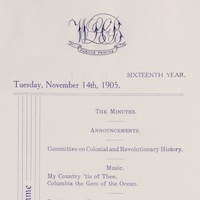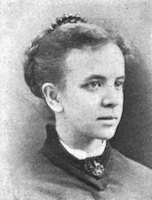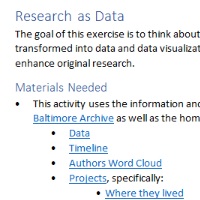Projects
The purpose of this archival site is to make further research possible. By transcribing manuscript documents to make them searchable, organizing geographical and biographical data, and making everything publicly accessible, the Woman’s Literary Club of Baltimore Archive is just a starting point for research on women in Baltimore, female authorship, and turn of the century American literary history. This page collects research projects completed by project team members.
What Happened at a Meeting?
The WLCB met every week throughout the fall, winter and spring months. What happened at a meeting? This exhibit created by Jean Lee Cole and Clara Love takes you through a typical program to provide a snapshot of what a meeting may have looked and sounded like. The exhibit also serves as an introduction to some of the resources available at the archive.
Where They Lived
Based on dues records and membership notebooks, this map created by Clara Love shows the flourishing of Baltimore literary culture in the area northwest of the city center at the turn of the century, as well as growing networks of female authorship developed over the course of the Club’s first three decades in existence.
Katharine Pearson Woods, Metzerott, Shoemaker, and the Woman’s Literary Club of Baltimore
Katharine Pearson Woods was a notable member of the Club whose works touched on areas such as: socialism, labor, immigration, religion, and more. This project includes an annotated edition of Woods’s first novel, Metzerott, Shoemaker (1889), an online exhibit about Woods, additional resources for understanding Woods’ work, and resources documenting the reception of Metzerott.
Pedagogical Resources
The Woman’s Literary Club of Baltimore Archive strives to make scholarship recovering the works and lives of Club members and the historical resources they created accessible to a wider audience. To meet that goal, the project team has created two lesson plans that can be used to explore areas critical to understanding the project: data visualizations and the research that underpins them as well as the often difficult process of finding information about Club members.



